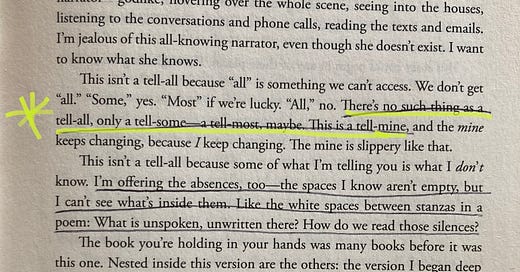Welcome to Slant Letter’s spring seasonal intensive, starting today! Become a paid subscriber to join our close reading of Maggie Smith’s You Could Make This Place Beautiful for an editor’s annotated insights on an extraordinary memoir that all writers can learn from. These will be exclusive letters sent straight to you running from April through May. Join us!
Maggie Smith is a poet, which means not just every word, but every syllable is by design. She could have opened her book anywhere, but this is how she chose to do it: by subverting a cheap cliché, and reframing it.
“There’s no such thing as a tell-all.”
From the opening page:
“Before we go any further together, me with my lanterns, you following close behind, light flickering on both of our faces, I want to be clear about something: This isn't a tell-all. A tell-all would need an omniscient narrator- godlike, hovering over the whole scene, seeing into the houses, listening to the conversations and phone calls, reading the texts and emails.
I'm jealous of this all-knowing narrator, even though she doesn't exist. I want to know what she knows . . . There’s no such thing as a tell-all, only a tell-some—a tell-most, maybe. This is a tell-mine.”
Maggie Smith begins her acclaimed, bestselling, and most of all, deeply personal memoir with a prologue that functions as an asterisk. A caveat.
If you trace its etymology back to its Latin roots, you’ll find “caveat” means simply, “let a person beware.”
The caveat is a way of leveling with your reader: this is what you will find here, and this is what you won’t. It is a signpost as if to say, just so you are aware… It is an antidote to overpromising, misleading, obscuring, or confusing the thread. Ultimately, the caveat is a writer’s tool and technique for guiding their readers into awareness of what they’re trying to say, as well as what they’re not.
Make no mistake: Smith is going to tell it slant, but first, she’s going to tell us straight—and the way she does it is an art form. Let the writers take notes! And today we are, as we explore Smith’s creative choice to begin where she did, as well as what the caveat can do for you in your own writing.




